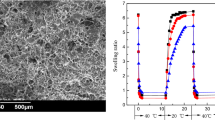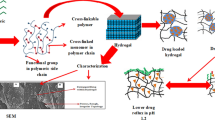Abstract
Xylan sulfate, one important xylan derivative, was prepared using microfluidic reactor system and incorporated in situ under the polymerization of methacroylcholine chloride (DMC), resulting in composite hydrogels containing variable amount of xylan sulfate. The introduction of xylan sulfate imparts enhanced temperature-swelling responsiveness to the hydrogels, and substantially increases their water swelling ratio up to > 200 g/g, which is twice higher than the neat polyDMC hydrogel. Such swelling behavior may relate to the electrostatic interaction between the –SO3− in xylan sulfate and the –NH4+ in polyDMC. This interaction significantly improves the formation of porous architecture and the tensile toughness of the hydrogels. The composite hydrogels exhibit responsive swelling behavior at different salt, pH, and solvent conditions due to osmotic pressure decline, charge shielding and salting-out effect. They load 2.2 times amount of tetracycline hydrochloride and show 50.3% slower release rate than the neat polyDMC hydrogel, which shows great potential for drug delivery applications.
Graphic abstract












Similar content being viewed by others
References
Ahmed EM (2015) Hydrogel: preparation, characterization, and applications: a review. J Adv Res 6:105–121
Anderson VR, Perry CM (2006) Pentosan polysulfate. Drugs 66:821–835
Barbucci R, Magnani A, Consumi M (2000) Swelling behavior of carboxymethylcellulose hydrogels in relation to cross-linking, pH, and charge density. Macromolecules 33:7475–7480
Bush JR, Liang H, Dickinson M, Botchwey EA (2016) Xylan hemicellulose improves chitosan hydrogel for bone tissue regeneration. Polym Adv Technol 27:1050–1055
Chen Y et al (2019) Flow synthesis, characterization, anticoagulant activity of xylan sulfate from sugarcane bagasse. Int J Biol Macromol 155:1460–1467
Cheng H, Liu H, Feng Q, Xie Y, Zhan H (2017) Preparation, characterization and in vitro anticoagulant activity of corn stover xylan sulfates. J Biomat Sci Polym E 28:271–283
Dai H, Huang H (2017) Enhanced swelling and responsive properties of pineapple peel carboxymethyl cellulose-g-poly (acrylic acid-co-acrylamide) superabsorbent hydrogel by the introduction of carclazyte. J Agric Food Chem 65:565–574
Daus S, Petzold-Welcke K, Kötteritzsch M, Baumgaertel A, Schubert US, Heinze T (2011) Homogeneous sulfation of xylan from different sources. Macromol Mater Eng 296:551–561
Debele TA, Mekuria SL, Tsai HC (2016) Polysaccharide based nanogels in the drug delivery system: application as the carrier of pharmaceutical agents. Mater Sci Eng C 68:964–981
Du J, Li B, Li C, Zhang Y, Yu G, Wang H, Mu X (2016) Tough and multi-responsive hydrogel based on the hemicellulose from the spent liquor of viscose process. Int J Biol Macromol 88:451–456
Ebringerová A, Hromádková Z, Heinze T (2005) Hemicellulose. In: Heinze T (ed) Polysaccharides I. Springer, Berlin, pp 1–67
Flory PJ (1953) Principles of polymer chemistry. Cornell University Press, New York
Gabrielii I, Gatenholm P, Glasser W, Jain R, Kenne L (2000) Separation, characterization and hydrogel-formation of hemicellulose from aspen wood. Carbohydr Polym 43:367–374
Gao C, Ren J, Kong W, Sun R, Chen Q (2015) Comparative study on temperature/pH sensitive xylan-based hydrogels: their properties and drug controlled release. RSC Adv 5:90671–90681
García-Uriostegui L, Delgado E, Meléndez-Ortiz HI, Camacho-Villegas T, Esquivel-Solís H, Gatenholm P, Toriz G (2018) Spruce xylan/HEMA-SBA15 hybrid hydrogels as a potential scaffold for fibroblast growth and attachment. Carbohydr Polym 201:490–499
Gong JP (2010) Why are double network hydrogels so tough? Soft Matter 6:2583–2590
Katsuraya K, Nakashima H, Yamamoto N, Uryu T (1999) Synthesis of sulfated oligosaccharide glycosides having high anti-HIV activity and the relationship between activity and chemical structure. Carbohydr Res 315:234–242
Košovan P, Richter T, Holm C (2015) Modeling of polyelectrolyte gels in equilibrium with salt solutions. Macromolecules 48:7698–7708
Lian Y, Zhang J, Li N, Ping Q (2018) Preparation of hemicellulose-based hydrogel and its application as an adsorbent towards heavy metal ions. BioResources 13:3208–3218
Liu J, Li Q, Su Y, Yue Q, Gao B (2014) Characterization and swelling–deswelling properties of wheat straw cellulose based semi-IPNs hydrogel. Carbohydr Polym 107:232–240
Liu S, Chen F, Song X, Wu H (2017) Preparation and characterization of temperature- and pH-sensitive hemicellulose-containing hydrogels. Int J Polym Anal Charact 22:187–201
Luo F et al (2015) Oppositely charged polyelectrolytes form tough, self-healing, and rebuildable hydrogels. Adv Mater 27:2722–2727
Madhawan A, Arora A, Das J, Kuila A, Sharma V (2018) Microreactor technology for biodiesel production: a review. Biomass Convers Biorefin 8:485–496
Mandal P, Pujol CA, Damonte EB, Ghosh T, Ray B (2010) Xylans from Scinaia hatei: structural features, sulfation and anti-HSV activity. Int J Biol Macromol 46:173–178
Naidu DS, Hlangothi SP, John MJ (2018) Bio-based products from xylan: a review. Carbohydr Polym 179:28–41
Peng X, Ren J, Zhong L, Peng F, Sun R (2011) Xylan-rich hemicelluloses-graft-acrylic acid ionic hydrogels with rapid responses to pH, salt, and organic solvents. J Agric Food Chem 59:8208–8215
Peng F, Guan Y, Zhang B, Bian J, Ren J, Yao C, Sun R (2014) Synthesis and properties of hemicelluloses-based semi-IPN hydrogels. Int J Biol Macromol 65:564–572
Petzold-Welcke K, Schwikal K, Daus S, Heinze T (2014) Xylan derivatives and their application potential–mini-review of own results. Carbohydr Polym 100:80–88
Qi X et al (2016) Enhanced mechanical performance of biocompatible hemicelluloses-based hydrogel via chain extension. Sci Rep 6:33603
Ren J, Dai Q, Zhong H, Liu X, Meng L, Wang X, Xin F (2018) Quaternized xylan/cellulose nanocrystal reinforced magnetic hydrogels with high strength. Cellulose 25:4537–4549
Sun X, Wang H, Jing Z, Mohanathas R (2013) Hemicellulose-based pH-sensitive and biodegradable hydrogel for controlled drug delivery. Carbohydr Polym 92:1357–1366
Sun XF, Gan Z, Jing Z, Wang H, Wang D, Jin Y (2015) Adsorption of methylene blue on hemicellulose-based stimuli-responsive porous hydrogel. J Appl Polym Sci 132:41606
Sun X-F, Zeng Q, Wang H, Hao Y (2019) Preparation and swelling behavior of pH/temperature responsive semi-IPN hydrogel based on carboxymethyl xylan and poly (N-isopropyl acrylamide). Cellulose 26:1909–1922
Utech S, Boccaccini AR (2016) A review of hydrogel-based composites for biomedical applications: enhancement of hydrogel properties by addition of rigid inorganic fillers. J Mater Sci 51:271–310
Wagner W (1989) Hoe/Bay 946—a new compound with activity against the AIDS virus. Arzneimittel-Forschung 39:112
Xiao Z et al (2018) Fast swelling behaviors of thermosensitive poly (N-isopropylacrylamide-co-methacryloxyethyltrimethyl ammonium chloride)/Na2WO4 cationic composite hydrogels. J Appl Polym Sci 135:46375
Yang J, Du Y, Wen Y, Li T, Hu L (2003) Sulfation of Chinese lacquer polysaccharides in different solvents. Carbohydr Polym 52:397–403
Yuan T, Xu F, He J, Sun R (2010) Structural and physico-chemical characterization of hemicelluloses from ultrasound-assisted extractions of partially delignified fast-growing poplar wood through organic solvent and alkaline solutions. Biotechnol Adv 28:583–593
Acknowledgments
The authors thank the financial support by the National Key Research and Development Program of China (2019YFD1101202); Program for the Jiangsu Province Natural Science Foundation for Distinguished Young Scholars (SBK20190035); National Natural Science Foundation of China (21776132, 21878142); Natural Science Foundation of the Jiangsu Higher Education Institutions (19KJB530002); Changjiang Scholars and Innovative Research Team in University (Grant No. IRT_14R28); and Jiangsu National Synergetic Innovation Center for Advanced Bio-Manufacture.
Author information
Authors and Affiliations
Corresponding authors
Additional information
Publisher's Note
Springer Nature remains neutral with regard to jurisdictional claims in published maps and institutional affiliations.
Electronic supplementary material
Rights and permissions
About this article
Cite this article
Li, M., Sun, X., Chen, Y. et al. Effect of xylan sulfate on the responsive swelling behavior of poly(methacrylatoethyl trimethyl ammonium chloride)-based composite hydrogels. Cellulose 27, 8745–8756 (2020). https://doi.org/10.1007/s10570-020-03402-4
Received:
Accepted:
Published:
Issue Date:
DOI: https://doi.org/10.1007/s10570-020-03402-4




